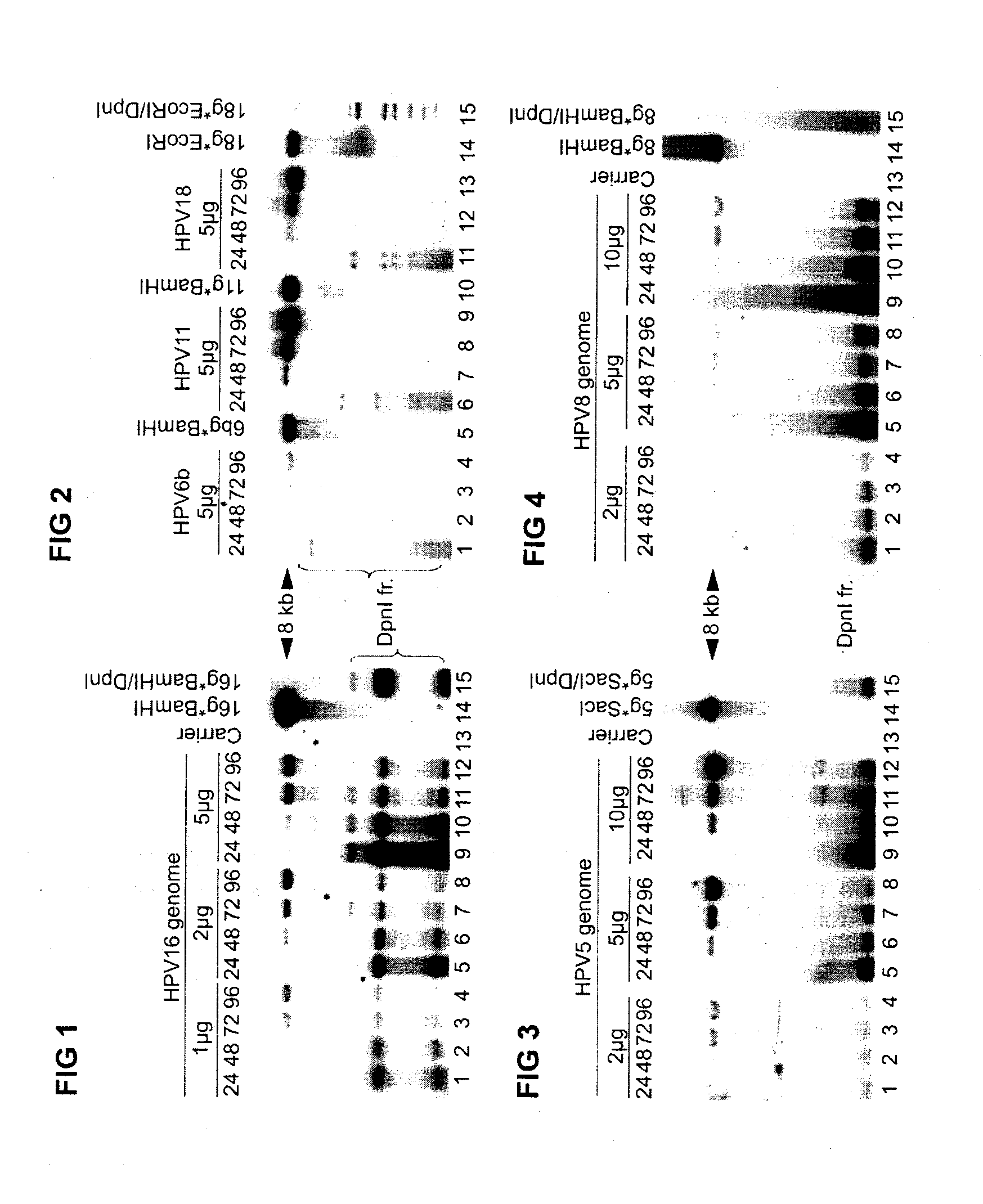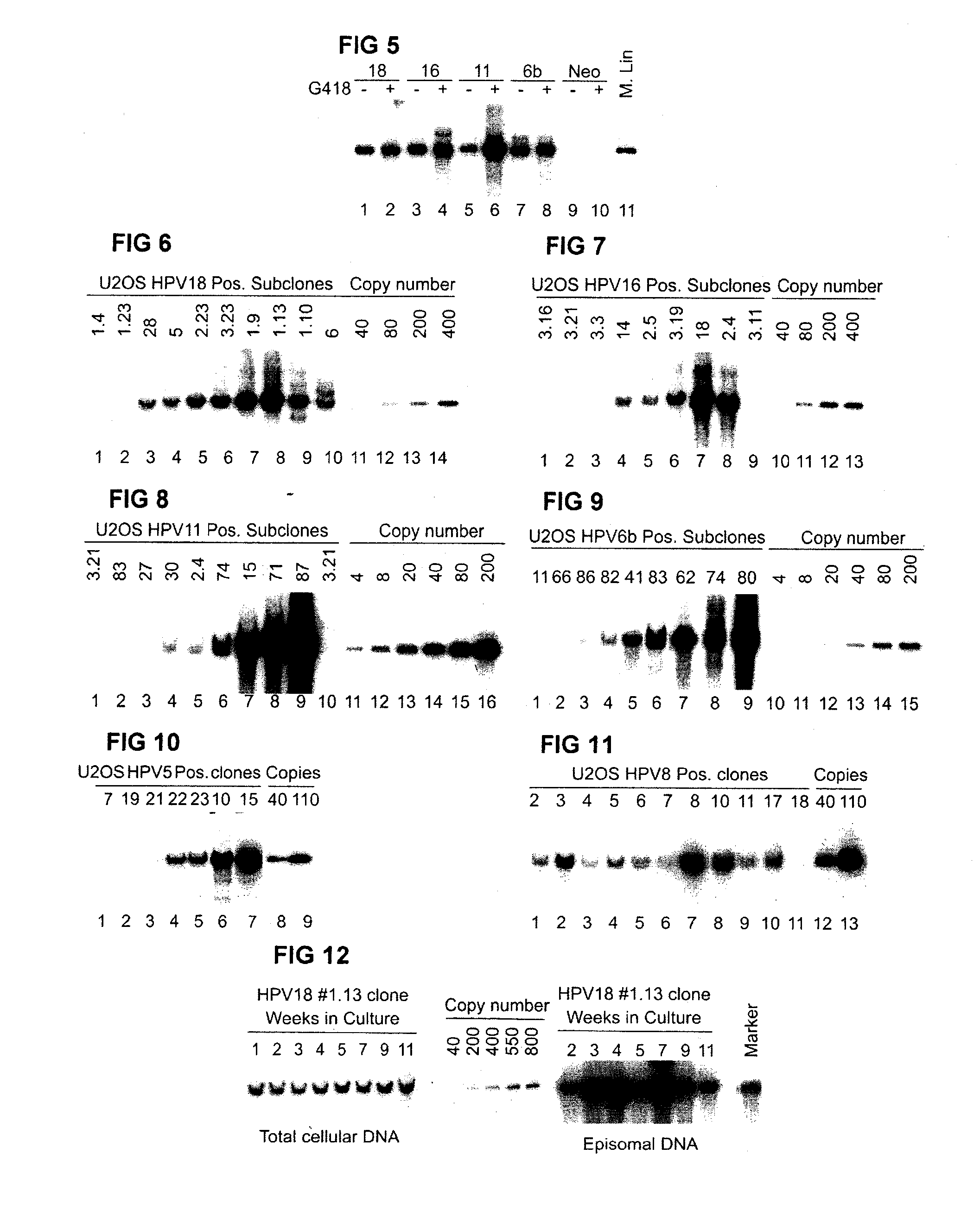Method and Kit for Identifying Compounds Capable of Inhibiting Human Papilloma Virus Replication
a human papilloma virus and anti-hpv technology, applied in the field of virology, cell culturing, drug development, can solve the problems of malignant carcinoma progression and formation, cell modelling of these replication stages in cells is problematic, and most tissue culture cells do not support any mode of hpv genomic replication
- Summary
- Abstract
- Description
- Claims
- Application Information
AI Technical Summary
Benefits of technology
Problems solved by technology
Method used
Image
Examples
example 1
Transient HPV DNA Replication in U2OS Cells
[0099]Human papillomaviruses show strong tropism for epithelial cells. It was discovered that human osteosarcoma cell line U2OS, exhibiting epithelial adherent morphology, although derived from a moderately differentiated osteosarcoma, supported very effectively the HPV E1 and E2 protein dependent viral DNA replication, when the expression-vectors for viral replication proteins were used together with reporter plasmids containing viral origin. U2OS cells encode wild-type pRb and p53.
[0100]Hereafter it was investigated, whether the viral trans factors (E1 and E2) could act in their native configurations supporting the replication of the viral genomes in U2OS monolayer cultures. A set of four different cutaneous type of papillomaviruses were included, two of them belonging to high-risk type (HR / HPV-18 and HR / HPV-16) and two to low-risk type (LR / HPV-11 and LR / HPV-6b) according to their prognosis for cancer development. Additionally, two subtyp...
example 2
HPV Stable Replication in U2OS Monolayer Cultures
Establishment of Persistent HPV Stable Maintenance in U2OS Cell Line
[0103]Quite strong HPV genomic DNA replication signal in U2OS cells in transient assays suggested further evaluation of the capacity of HR- and LR-HPV plasmids for stable episomal replication. For this purpose we co-transfected into U2OS cells 5 μg of HPV-6b, or HPV-11, HPV-16, HPV-18, HPV-5, HPV-8 circular plasmid together with 5 μg AraD carrier DNA and with 2 μg of Eco01091-linearized of pNeo-EGFP or EcoRI-linearized pBabeNeo plasmid, encoding antibiotic resistance marker, which would allow the selection for the transfected cells. 48 hrs after the transfection G418 selection was performed. After two to three weeks of cultivation with G418 selection, the low-molecular weight (LMW) Hirt extracts from whole cell population (“pool” DNA) were analyzed by Southern blotting with radioactively labelled probes against the appropriate HPV types. The analysis shows that all te...
example 3
Late Amplification of the HPV Genomes
Genome Amplification in a Manner Similar to Differentiation-Dependent Viral Amplification
[0108]In the productive stage of PV life cycle, amplification of the viral genome occurs in differentiated cells within the upper layer of epidermis. To study the productive stage of viral life cycle in tissue culture, the three-dimensional architecture of the epithelium has been usually tried to be reproduced with organotypic or raft cultures, suspension in methylcellulose, feeder cells, by using regulated culture and growth conditions.
[0109]We used an alternative method, only dense cell cultures to imitate differentiation-dependent viral amplification. For this purpose equal number of cells (for example 1×106 cells per 10 cm culture dish) of appropriate HPV-positive cell clone were split on several dishes (for example 6) and maintained as regular confluent monolayers grown up to high densities. The total DNA or low molecular weight (Hirt) DNA samples were c...
PUM
| Property | Measurement | Unit |
|---|---|---|
| concentrations | aaaaa | aaaaa |
| volume | aaaaa | aaaaa |
| volume | aaaaa | aaaaa |
Abstract
Description
Claims
Application Information
 Login to View More
Login to View More - R&D
- Intellectual Property
- Life Sciences
- Materials
- Tech Scout
- Unparalleled Data Quality
- Higher Quality Content
- 60% Fewer Hallucinations
Browse by: Latest US Patents, China's latest patents, Technical Efficacy Thesaurus, Application Domain, Technology Topic, Popular Technical Reports.
© 2025 PatSnap. All rights reserved.Legal|Privacy policy|Modern Slavery Act Transparency Statement|Sitemap|About US| Contact US: help@patsnap.com



